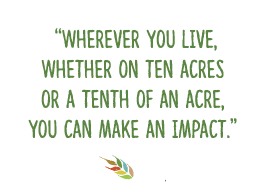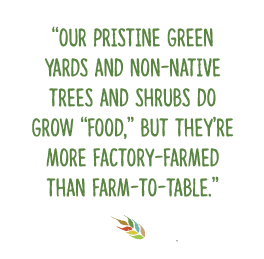Coop Scoop Blog
Is Your Yard Healthy? Ask the Birds!
“Wow, is this place GREEN!” exclaimed my sister back in May, during her first-ever visit to the Capital Region. We were standing in the parking lot of a busy steakhouse in downtown Albany. I looked up and around, perplexed by the sight of concrete and glass all around us. “Well, I mean on the drive here,” she explained, “it was really green. Like, you must have a ton of animals running around and stuff. Lots of birds,” she smiled, and poked me in the rib.
It’s true, we do have lots of birds in upstate New York. My sister knows this because I’ve become a “birder,” or bird watcher, over the last few years—otherwise known as “that person who can’t have a normal conversation in the outdoors anymore because… Ahhhh stop! Look! There’s a bird!”
Apart from teaching me how to embrace distracted personalities, bird watching has expanded my entire  understanding of the natural world. I don’t just see birds everywhere, I see the incredible variety of places they need—from beach dunes to forest edge, wetlands to dead tree trunks. In our backyards, they need flowers, bushes, grasses, and trees. But it’s even more complex than that.
understanding of the natural world. I don’t just see birds everywhere, I see the incredible variety of places they need—from beach dunes to forest edge, wetlands to dead tree trunks. In our backyards, they need flowers, bushes, grasses, and trees. But it’s even more complex than that.
Birds depend on native plants to thrive. Unfortunately, the modern obsession with highly manicured grass lawns has created a monoculture carpet across the country, and that’s not good news for birds, bees, or insects.
The Myth of Green
“The chemicals we use in our yards are one of the largest sources of pollution contaminating our drinking water today,” states Diane Lewis, MD, in her book The Great Healthy Yard Project. The chemicals used to keep our yards, parks, and public spaces green “wash with rain and storm water into our streams, lakes, reservoirs…” all in the name of keeping up appearances.
You can avoid the need for harmful chemicals by planting native trees and flowers, rather than ornamental non-natives or invasives. Instead of tulip flowers, try tulip poplar, a tree celebrated for its bright yellow-orange blooms. Use trumpet honeysuckle twines in place of Japanese honeysuckle. Plant wild strawberry and mountain mint fields in place of traditional lawns. This will produce a wide variety of birds darting in and about your garden, landing on woody stems to pick at flower seeds and catch the now-thriving variety of insects zooming and crawling around.
Contrast that with areas dominated by non-native plants, where productivity drops—not just for lack of food, but lack of nutritious options. Our pristine green yards and non-native trees and shrubs do grow “food,” but they’re more factory-farmed than farm-to-table.
Not All That Glitters Is Gold
Why do so many non-native, exotic plants dominate our landscapes? Three easy answers: either they’re pretty, they’re invasive, or they’re some combination of both—like exotic bush honeysuckle. This invasive species can be spotted along forest edges and roadsides, although it was originally used in ornamental gardens. They out-compete native plants for soil moisture, light, and nutrients, and while they are favored by pollinators, you might think of them more like delicious junk food. Berries of the exotic honeysuckles lack the high-fat content migratory birds need for long flights.
 Birds that live year-round in our state, as well as those that migrate through, depend on high-fat and high-protein diets, and that comes from the berries, nuts, and seeds of native plants. It also comes from insects—which native plants “host” in far greater numbers than non-native ones.
Birds that live year-round in our state, as well as those that migrate through, depend on high-fat and high-protein diets, and that comes from the berries, nuts, and seeds of native plants. It also comes from insects—which native plants “host” in far greater numbers than non-native ones.
It can take hundreds of insects a day to feed just one family of birds. Research by the entomologist Doug Tallamy has shown that native oak trees support over 500 species of caterpillars, whereas ginkgos, a commonly planted landscape tree from Asia, host only five species of caterpillars. Add native trees to your yard, like the American basswood or northern white oak, and you’ll provide essential, healthy food for birds.
Wherever you live, whether on ten acres or a tenth of an acre, you can make an impact. Imagine a single spicebush in your yard this fall; a big, yellow-gold leafed shrub that produces green berries. Long-distance migrants like the wood thrush, getting ready to fly 100 miles the next evening, will spend all day refueling at this “Spicebush Station.” Congratulations, you’ve provided at least one threatened bird with a critical place to rest and rejuvenate before a long journey to Central America!
Need More Reasons for Natives?
Native plants are adapted to local precipitation and soil conditions, so they save time, water, and money on upkeep. They require less fertilization, and less pesticide application, and they don’t require mowing.
“Native insects are specialists that have co-evolved with native plants for thousands of years. They cannot survive without them. Native birds and amphibians depend on specific insects, so they, too, are threatened, and so on up the food chain,” says Lewis.
Adding native plants to your garden can help preserve and improve our state’s incredible biodiversity. Now that you know, grow!
Native Plants for New Yorkers
TREES
Allegheny Serviceberry
Blooms and fruits in early summer, producing white flowers followed by red, purple, or black berries. Popular with fruit-eating birds.
Flowering Dogwood
White flowers bloom from spring to fall, bright red fruits mature in late summer to early fall and may persist until late in the year. It is resistant to browsing by deer, and attracts caterpillars, butterflies, orioles, warblers, waxwings, and more.
ANNUALS AND PERENNIALS
Black-Eyed Susan
Daisy-like flowers are yellow with a brownish-purple center, and bloom on rough stalks from June to October. Attracts birds for its seeds and pollinating insects for its nectar, and is resistant to browsing by deer.
Red Columbine
Bring hummingbirds to your yard with this perennial’s uniquely bell-shaped red flowers. Also known as Eastern red columbine and wild columbine.
Wreath (Bluestem) Goldenrod and Wrinkle-Leaf Goldenrod
Brightly colored yellow flowers make wreath goldenrod a popular stop for butterflies, while the tiny yellow flowers of wrinkle-leaf goldenrod offer a valuable source of food for honeybees.
Resources
A searchable database—put in your zip code to find native plants that will thrive in your area: https://www.audubon.org/plantsforbirds
Lewis, Diane. The Great Healthy Yard Project. She Writes Press, 2014.
AUTHOR BIO:
Sharon Bruce is a gardener, cookie baker, and nonprofit communicator.
